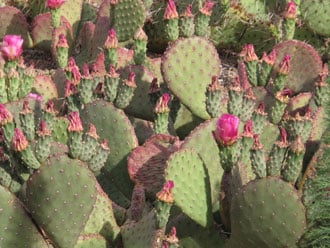

Contributor
- Topics: Archive

Most rooftop gardens and green roofs experience climate extremes that make plant selection especially challenging. Both the 10,000-square-foot green roof on Chicago City Hall, and the 20,000-square-foot green roof on the Environmental Protection Agency (EPA) building in Denver, endure drastic fluctuations in temperature and wind speed every 24-hours, year- round. On the top floor of the EPA roof, wind speed clocks in at more than 50 miles per hour, and temperatures vary from -25°F in winter to 105°F in the hottest part of the summer.
In addition to dramatic seasonal and daily climate variations, rooftop plants typically grow in just four to twelve inches of substrate. The growing medium— usually expanded shale or slate mixed with compost—is highly porous, well-drained, and depending on the percentage of compost, nutrient poor—abysmal growing conditions for most plants. However, many drought- adapted plants thrive in these conditions. Identifying and utilizing suitable plants is key to building healthy green roofs with low irrigation and maintenance requirements in the arid West.

Moving Beyond Sedums
While aesthetics play a major role in the design of many green roofs, budget considerations and economic incentives are often the primary motivators for implementing medium- and large-scale projects. Most building owners want the benefits of a green roof coupled with lower operating costs. A healthy green roof can evolve into a low-maintenance ecosystem that sequesters nitrogen oxide, retains stormwater, and provides aesthetic value, along with a laundry list of other standard green roof benefits. Biodiversity is increasingly understood to contribute to successful green roof plantings. Work by Dr. Brad Bass at the University of Toronto supports the idea that greater plant diversity leads to healthier conditions and increased cooling.

Sedums are adapted to growing in minimal soil and withstanding extreme temperature fluctuations and desiccating winds. Their success in many rooftop gardens and green roofs in Europe and eastern North America has been well documented, and many roofs throughout North America are covered in green mats of Sedum album, S. sexangulare, S. spurium and S. kamtschaticum. However, in many places throughout the West it is challenging for these plants to flourish during the hottest times of the year. To create regionally adapted and successful green roofs, I would like to see specific plants identified and integrated with proven performers like sedums and native grasses. Forbs like Yellow Ice Plant (Delosperma nubigenum), Yarrow (Achillea millefolium), Fame Flower—or rock pink (Phemeranthus calycinum), and grasses like Prairie Dropseed (Sporobolus heterolepis), Idaho Blue Fescue (Festuca idahoensis) and Blue Grama Grass (Chondrosum gracile syn. Bouteloua gracilis) are gaining popularity on North American green roofs. Many of these plants perform well in the West, but there are hundreds more possibilities and plant species to explore.

Regional plants offer promise for green roof application since the growing conditions in many natural areas in the western United States—desert, plain, and mountain regions—mimic those found on a green roof with cold, dry, windy and desiccating winters followed by short springs and hot summers. Higher elevation areas from the North American steppe, subalpine, and alpine regions, to the Mojave, Sonoran, Chihuahuan, and Great Basin deserts undergo daily temperature fluctuations of 40°F or more. Plants growing on rocky outcrops or in talus, scree, and sand thrive in shallow, well-drained soil and with little protection from wind, sun, and cold. It is important to note that not all species living in these habitats are suitable for planting on a green roof. Many of the plants growing in the aforementioned regions and plant communities have long taproots or need particular soil conditions to thrive. Still, there are most likely a few hundred species, unrelated to sedum, that merit further testing for green roof planting.
So what are the best plants for a green roof in the western United States? It is a valid question and one that doesn’t have a simple answer. As with all gardens, hardiness zones, microclimates, site elevation, and exposure determine which plants will succeed. An understanding of local flora and drought-adapted species is valuable, as is research and trialing plants from sagebrush, alpine, and prairie communities like milk vetch (Astragalus), sandwort (Arenaria), and pincushions (Chaenactis). With more than 200 species, the buckwheat genus (Eriogonum) is sure to yield at least a couple that are adapted to green roofs; I have seen Sulphur Buckwheat (E. umbellatum) doing well growing in six inches of soil on a green roof in Colorado. Numerous paddle cactus (Opuntia) adapt perfectly to green roof growing conditions; other promising genera like Agave, Sphaeralcea, Physaria, and Phacelia, have multiple species throughout the West with green roof planting potential.

While drought adapted in terrestrial situations, the plants mentioned above require supplemental water when planted on a roof. As a rule, regardless of location, most green roofs should have irrigation as even a short drought can imperil a planting. (Recently, even Atlanta, Georgia, has experienced dry conditions.) Considering the initial investment of installing a green roof, it is worth the additional cost to incorporate a basic irrigation system. The only exception might be an all-Opuntia roof.
Given the necessity of irrigation on green roofs and the continued debate about water issues and the future of green roofs in the arid West, many people question if using additional water to irrigate roof top gardens is worth it. The green roof at Denver Botanic Gardens thrives on only 1/4-inch of water per week from June through September. This relatively moderate amount of irrigation gets plants through the hottest time of the year and moderates temperatures of the roof membrane and the ambient air above the roof on even the hottest days.

Along with a good preliminary design and considered plant selection, ongoing maintenance is paramount to a high-functioning green roof. Even a small budget for a trained professional hired to care for a green roof allows for responsive adjustments to plant material and irrigation and provides invaluable insurance against failure. Introducing and monitoring the performance of previously untested species that may prove climate- appropriate and provide diversity can become a part of the overall maintenance plan as well.
It’s an exciting time as green roofs become an ever more important part of the built environment in North America. When well designed and executed, green roof projects planted with a diverse and expanded plant palette in climates previously thought to be inhospitable offer increased design potential and provide the greatest benefit to building owners, occupants, and society.
Living (P)roof

The following plants perform well in five to seven inches of growing medium. This list is not exhaustiveand most of these plants are not new to horticulture.
• Scarlet Gilia (Ipomopsis aggregata)
• Red Yucca (Hesperaloe parviflora)
• Sulphur Buckwheat (Eriogonum umbellatum)
• Cutleaf Daisy (Erigeron compositus)
• Plains Pricklypear (Opuntia polyacantha)
• Spearleaf Stonecrop (Sedum lanceolatum)
Roofs engineered for a deeper soil horizon will support the addition of woody shrubs that provide cover and habitat for birds and insects and may sequester more nitrogen oxide than herbaceous perennials.
• Dwarf Indigobush (Amorpha nana)
• Mountain Mahogany (Cercocarpus ledifolius)
• Manzanita (Arctostaphylos ×coloradoensis)
With an increase in elevation, there are a few alpine and subalpine plants that can do quite well on green roofs. The following plants do well in mountain communities above 6,000 feet.
• Moss Campion (Silene acaulis)
• Prairie Sagewort (Artemisia frigida) also works well at lower elevations
• Dwarf Phlox (Phlox condensata)
• Narrow Oatgrass (Koeleria spicata)

Share:
Social Media
Garden Futurist Podcast
Most Popular
Videos
Topics
Related Posts

Low Maintenance Gardens – Better for Pollinators and People
Autumn 2022 “I come out every day. It’s therapy, my meditation.” Janet’s young garden transformed from overgrown, invasive plants to mostly natives. The dailiness of

Invasive Plants Are Still Being Sold: Preventing Noxious Weeds in Your Landscape
Autumn 2022 With so many beautiful ornamental plant species and cultivars throughout California and the Pacific Northwest, how do you decide which ones to include

Garden Design in Steppe with Transforming Landscapes with Garden Futurist Emmanuel Didier
Summer 2022 Listen to full Garden Futurist: Episode XVII podcast here. Emmanuel Didier, Principal and Creative Director at Didier Design Studio is a leading figure

Seslerias: Versatile Groundcover Meadow Grasses
Summer 2022 Without question, the most beautiful and versatile of all the groundcover meadow grasses are the moor grasses (Sesleria). Moor grasses tick off all









Responses